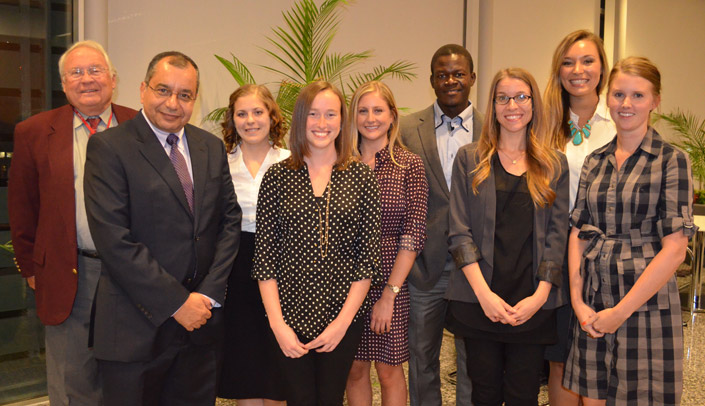Language differences, medical records that were incomplete, inconsistent and full of holes (bug holes), and lack of trust, electricity and access to the Internet were some of the barriers and challenges to research cited most by students who went to Africa this summer from UNMC’s College of Public Health.
Projects
The students who participated in the event and their projects are:
- Jaime Gabel: Epidemiologic and clinical profiles of esophageal cancer in Tanzania.
- Amanda Meyer: Reproductive and clinical demographics of patients undergoing visual inspection of the cervix in rural Tanzania.
- Trisha Reynolds: Cervical cancer screening among HIV-positive women in rural Tanzania.
- Salomon Compaore: Epidemiologic profiles of cervical cancer screening and treatment patients in Burkina Faso.
- Kate Rieke: Depression and treatment decision making among SEER-Medicare cancer patients.
- Stephanie Nelson: Cost-benefit of screening versus treatment for cervical cancer in Tanzania.
- Brittney Smith: Variable incidence of stomach cancer in Morocco.
Five students from UNMC and two from the University of Michigan School of Public Health (U-M), Ann Arbor, presented their cancer research projects at the Cancer Epidemiology Education in Special Populations (CEESP) program dinner Oct. 2.
All but one conducted their research in Africa; the seventh was completed in the U.S. Students studied the incidence of head and neck cancer in Nebraska, and cervical, stomach and esophageal cancers in Tanzania, Morocco and Burkina Faso.
A total of 12 UNMC students had been part of the only program of its kind among schools of public health in the U.S., said Amr Soliman, M.D., Ph.D., professor and chairman of epidemiology and the principal investigator and director of CEESP.
The CEESP program, funded by a National Cancer Institute grant since 2006 with in-kind support from UNMC, supports M.P.H. and Ph.D. students as they conduct mentored field research related to minority populations within the U.S. and international settings. Students learn about cancer epidemiology in special populations as well as translation of epidemiology into cancer control and prevention interventions.
The students found variable rates of cancer between international settings and vast gaps in knowledge about these cancers among the patient populations. Salomon Compaore, M.D., who conducted his project in his native country of Burkino Faso, said many of the women confused cervical cancer with breast cancer.
Life expectancy for women in Tanzania is 61 years. Cervical cancer is the most prevalent of the cancers and also the leading cause of death among Eastern African women, said Trisha Reynolds, from U-M. She studied the rate of cervical cancer among HIV-positive women.
Brittany Smith, who spent her second summer in Morocco, based her study of stomach cancer on a physician-reported difference in incidence rate between Casablanca and Marrakesh – a distance of 150 miles. She confirmed a higher rate of disease in Marrakesh, but also noted that the majority of patients from Marrakesh may actually be coming from two adjoining regions.
Dr. Soliman praised the resourcefulness, perseverance and can-do attitude of the students and the learning experience and research productivity of the projects.
“These students truly overcame many obstacles to conduct their research,” he said.
